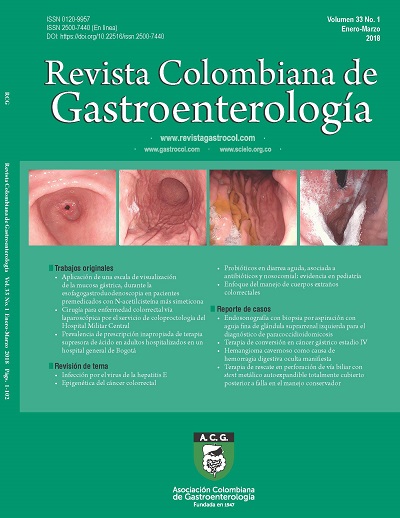Infección por el virus de la hepatitis E: clínica y epidemiología
DOI:
https://doi.org/10.22516/25007440.227Palavras-chave:
Virus de la hepatitis E, infección, revisión, ColombiaResumo
El virus de la hepatitis E es un patógeno hepatotrópico transmitido por agua y alimentos contaminados, y uno de los principales agentes etiológicos de hepatitis viral aguda de transmisión enteral en el mundo.
La infección por el virus de la hepatitis E usualmente es autolimitada; sin embargo, se han descrito casos de infección crónica en pacientes inmunocomprometidos. La infección autolimitada no requiere tratamiento; por el contrario, la infección crónica debe ser tratada por el riesgo de progresión a cirrosis y/o alguna de las manifestaciones extra hepáticas reportadas.
En Colombia la infección por el virus de la hepatitis E no hace parte del diagnóstico rutinario de hepatitis virales, a pesar de que existe evidencia de la circulación del virus en el país.
El presente artículo de revisión tiene como objetivo describir las generalidades del virus de la hepatitis E, así como la historia natural de la infección y los estudios realizados en Colombia que evidencian su presencia en el país. La revisión se realizó mediante una búsqueda de literatura en la base de datos PUBMED, SCIELO y ScienceDirect, de trabajos originales y revisiones de tema publicados entre el periodo 1983 y 2017.
Downloads
Referências
Balayan MS, Andjaparidze AG, Savinskaya SS, et al. Evidence for a virus in non-A, non-B hepatitis transmitted via the fecal-oral route. Intervirology. 1983;20(1):23-31.
https://doi.org/10.1159/000149370
Reyes GR, Purdy MA, Kim JP, et al. Isolation of a cDNA from the virus responsible for enterically transmitted non-A, non-B hepatitis. Science. 1990;247(4948):1335-9.
https://doi.org/10.1126/science.2107574
Echevarría JM, González JE, Lewis-Ximenez LL, et al. Hepatitis E virus infection in Latin America: a review. J Med Virol. 2013;85(6):1037-45.
https://doi.org/10.1002/jmv.23526
Organización Mundial de la Salud. Hepatitis E. OMS [Internet] 2016 [acceso el 4 de febrero de 2016]. Disponible en: http://www.who.int/mediacentre/factsheets/fs280/es/.
Gutiérrez CC, Ospina DA, Forero JE, et al. Detección serológica y molecular del virus de la Hepatitis E en cerdos de granjas antioque-as. CES Med Vet Zootec. 2014;9(2):158-68.
Rodríguez F, Jardi R, Buti M. Hepatitis E: virología molecular, epidemiología y patogénesis. Enferm Infecc Microbiol Clin. 2012;30(10):624-34.
https://doi.org/10.1016/j.eimc.2012.01.014
Forero J, Gutiérrez C, Parra J, et al. Evidencia serológica de infección por el virus de hepatitis E en cerdos faenados en Antioquia, Colombia. Rev MVZ Córdoba. 2015;20(2):4602-13.
https://doi.org/10.21897/rmvz.63
Báez P, Jaramillo CM, Arismendi L, et al. Evidencia molecular de virus de la hepatitis E en fuentes de agua en Antioquia. Biomédica. 2015;35(Supl 1):40-1.
International Committee on Taxonomy of Viruses. ICTV taxonomy history: Orthohepevirus A. ICTV [Internet] 2016 [acceso el 10 de febrero de 2016]. Disponible en: http://www.ictvonline.org/taxonomyHistory.asp?taxnode_id=20142432&taxa_name=Orthohepevirus%20A.
Yin X, Ambardekar C, Lu Y, et al. Distinct entry mechanisms for nonenveloped and quasi-enveloped hepatitis E viruses. J Virol. 2016;90(8):4232-42.
https://doi.org/10.1128/JVI.02804-15
Takahashi M, Tanaka T, Takahashi H, et al. Hepatitis E Virus (HEV) strains in serum samples can replicate efficiently in cultured cells despite the coexistence of HEV antibodies: characterization of HEV virions in blood circulation. J Clin Microbiol. 2010;48(4):1112-25.
https://doi.org/10.1128/JCM.02002-09
Okamoto H. Culture systems for hepatitis E virus. J Gastroenterol. 2013;48(2):147-58.
https://doi.org/10.1007/s00535-012-0682-0
Emerson SU, Arankalle VA, Purcell RH. Thermal stability of hepatitis E virus. J Infect Dis. 2005;192(5):930-3.
https://doi.org/10.1086/432488
Barnaud E, Rogée S, Garry P, et al. Thermal inactivation of infectious hepatitis E virus in experimentally contaminated food. Appl Environ Microbiol. 2012;78(15):5153-9.
https://doi.org/10.1128/AEM.00436-12
Lu L, Li C, Hagedorn CH. Phylogenetic analysis of global hepatitis E virus sequences: genetic diversity, subtypes and zoonosis. Rev Med Virol. 2006;16(1):5-36.
https://doi.org/10.1002/rmv.482
Holla RP, Ahmad I, Ahmad Z, et al. Molecular virology of hepatitis E virus. Semin Liver Dis. 2013;33(1):3-14.
https://doi.org/10.1055/s-0033-1338110
Panda SK, Thakral D, Rehman S. Hepatitis E virus. Rev Med Virol. 2007;17(3):151-80.
https://doi.org/10.1002/rmv.522
Zafrullah M, Ozdener MH, Panda SK, et al. The ORF3 protein of hepatitis E virus is a phosphoprotein that associates with the cytoskeleton. J Virol. 1997;71(12):9045-53.
Schlauder GG, Mushahwar IK. Genetic heterogeneity of hepatitis E virus. J Med Virol. 2001;65(2):282-92.
https://doi.org/10.1002/jmv.2031
Lee GH, Tan BH, Teo EC, et al. chronic infection with camelid hepatitis E virus in a liver transplant recipient who regularly consumes camel meat and milk. Gastroenterology. 2016;150(2):355-7.e3.
https://doi.org/10.1016/S0016-5085(16)31244-6
https://doi.org/10.1053/j.gastro.2015.10.048
Aggarwal R, Naik S. Epidemiology of hepatitis E: current status. J Gastroenterol Hepatol. 2009;24(9):1484-93.
https://doi.org/10.1111/j.1440-1746.2009.05933.x
García CG, Sánchez D, Villalba MC, et al. Molecular characterization of hepatitis E virus in patients with acute hepatitis in Venezuela. J Med Virol. 2012;84(7):1025-9.
https://doi.org/10.1002/jmv.23277
Mirazo S, Mainardi V, Ramos N, et al. Indigenous hepatitis E virus genotype 1 infection, Uruguay. Emerg Infect Dis. 2014;20(1):171-3.
https://doi.org/10.3201/eid2001.131471
Villalba Mde L, Lay Lde L, Chandra V, et al. Hepatitis E virus genotype 1, Cuba. Emerg Infect Dis. 2008;14(8):1320-2.
https://doi.org/10.3201/eid1408.080049
Navaneethan U, Al Mohajer M, Shata MT. Hepatitis E and pregnancy: understanding the pathogenesis. Liver Int. 2008;28(9):1190-9.
https://doi.org/10.1111/j.1478-3231.2008.01840.x
Kalia M, Chandra V, Rahman SA, et al. Heparan sulfate proteoglycans are required for cellular binding of the hepatitis E virus ORF2 capsid protein and for viral infection. J Virol. 2009;83(24):12714-24.
https://doi.org/10.1128/JVI.00717-09
Li TC, Takeda N, Miyamura T, et al. Essential elements of the capsid protein for self-assembly into empty virus-like particles of hepatitis E virus. J Virol. 2005;79(20):12999-3006.
https://doi.org/10.1128/JVI.79.20.12999-13006.2005
Williams TP, Kasorndorkbua C, Halbur PG, et al. Evidence of extrahepatic sites of replication of the hepatitis E virus in a swine model. J Clin Microbiol. 2001;39(9):3040-6.
https://doi.org/10.1128/JCM.39.9.3040-3046.2001
Liu P, Bu QN, Wang L, et al. Transmission of hepatitis E virus from rabbits to cynomolgus macaques. Emerg Infect Dis. 2013;19(4):559-65.
https://doi.org/10.3201/eid1904.120827
Shi R, Soomro MH, She R, et al. Evidence of hepatitis E virus breaking through the blood-brain barrier and replicating in the central nervous system. J Viral Hepat. 2016;23(11):930-9.
https://doi.org/10.1111/jvh.12557
Purcell RH, Emerson SU. Hepatitis E: an emerging awareness of an old disease. J Hepatol. 2008;48(3):494-503.
https://doi.org/10.1016/j.jhep.2007.12.008
Bihl F, Negro F. Hepatitis E virus: a zoonosis adapting to humans. J Antimicrob Chemother. 2010;65(5):817-21.
https://doi.org/10.1093/jac/dkq085
Fogeda M, Avellón A, Echevarría JM. Prevalence of specific antibody to hepatitis E virus in the general population of the community of Madrid, Spain. J Med Virol. 2012;84(1):71-4.
https://doi.org/10.1002/jmv.22270
Meng XJ. Hepatitis E virus: animal reservoirs and zoonotic risk. Vet Microbiol. 2010;140(3-4):256-65.
https://doi.org/10.1016/j.vetmic.2009.03.017
Betancur CA, Mejía MV, Portillo S. Seroprevalencia de hepatitis E en trabajadores de fincas porcícolas del Valle de Aburrá 2011-2012. Acta Médica Colomb. 2013;38(2):68-70.
Drobeniuc J, Favorov MO, Shapiro CN, et al. Hepatitis E virus antibody prevalence among persons who work with swine. J Infect Dis. 2001;184(12):1594-7.
https://doi.org/10.1086/324566
Meng XJ, Wiseman B, Elvinger F, et al. Prevalence of antibodies to hepatitis E virus in veterinarians working with swine and in normal blood donors in the United States and other countries. J Clin Microbiol. 2002;40(1):117-22.
https://doi.org/10.1128/JCM.40.1.117-122.2002
Gutiérrez CC, Rodríguez B, Parra J, et al. Determinación de anticuerpos totales (IgG/IgM) y específicos (IgM) para el virus de la hepatitis E y detección molecular del virus en heces de humanos con o sin exposición ocupacional a porcinos en 10 municipios de Antioquia. Iatreia. 2015;28(3):248-58.
Rendon J, Hoyos MC, di Filippo D, et al. Hepatitis E Virus Genotype 3 in Colombia: Survey in Patients with Clinical Diagnosis of Viral Hepatitis. PLoS One. 2016;11(2):e0148417.
https://doi.org/10.1371/journal.pone.0148417
Peláez D, Martínez D, Escalante M, et al. Coinfección del virus de la hepatitis E con otras hepatitis virales en Colombia y su caracterización genotípica. Biomédica. 2016;36(Supl):2-30.
Forero JE, Gutiérrez-Vergara C, Parra Suescún J, et al. Phylogenetic analysis of Hepatitis E virus strains isolated from slaughter-age pigs in Colombia. Infect Genet Evol. 2017;49:138-45.
https://doi.org/10.1016/j.meegid.2017.01.005
Peláez D, Hoyos MC, Rendón JC, et al. Infección por el virus de la hepatitis E en pacientes con diagnóstico clínico de hepatitis viral en Colombia. Biomédica. 2014;34(3):354-65.
https://doi.org/10.7705/biomedica.v34i3.2236
Duque A, Restrepo LF, Mantilla C, et al. Frecuencia de anticuerpos contra el virus de la hepatitis E en donantes de sangre del municipio de Yarumal, Antioquia. Rev Colomb Gastroenterol. 2016;31(3):229-34.
Forero JE, Parra JE, López A. Detección del genoma del virus de la hepatitis e (HVE) en muestras de heces de cerdos en plantas de beneficio de Antioquia, Colombia. Rev Med Vet Zoot. 2014;61(3):221-7.
https://doi.org/10.15446/rfmvz.v61n3.46868
Teshale EH, Hu DJ, Holmberg SD. The two faces of hepatitis E virus. Clin Infect Dis. 2010;51(3):328-34.
https://doi.org/10.1086/653943
Krawczynski K, Meng XJ, Rybczynska J. Pathogenetic elements of hepatitis E and animal models of HEV infection. Virus Res. 2011;161(1):78-83.
https://doi.org/10.1016/j.virusres.2011.03.007
Cattoir L, Van Hoecke F, Van Maerken T, et al. Hepatitis E virus serology and PCR: does the methodology matter? Arch Virol. 2017;162(9):2625-32.
https://doi.org/10.1007/s00705-017-3395-0
Khudyakov Y, Kamili S. Serological diagnostics of hepatitis E virus infection. Virus Res. 2011;161(1):84-92.
https://doi.org/10.1016/j.virusres.2011.06.006
Aggarwal R. Hepatitis E: clinical presentation in disease-endemic areas and diagnosis. Semin Liver Dis. 2013;33(1):30-40.
https://doi.org/10.1055/s-0033-1338112
Kamar N, Mansuy JM, Cointault O, et al. Hepatitis E virus-related cirrhosis in kidney- and kidney-pancreas-transplant recipients. Am J Transplant. 2008;8(8):1744-8.
https://doi.org/10.1111/j.1600-6143.2008.02286.x
Gérolami R, Moal V, Picard C, et al. Hepatitis E virus as an emerging cause of chronic liver disease in organ transplant recipients. J Hepatol. 2009;50(3):622-4.
https://doi.org/10.1016/j.jhep.2008.12.008
Kamar N, Garrouste C, Haagsma EB, et al. Factors associated with chronic hepatitis in patients with hepatitis E virus infection who have received solid organ transplants. Gastroenterology. 2011;140(5):1481-9.
https://doi.org/10.1053/j.gastro.2011.02.050
Kamar N, Lhomme S, Abravanel F, et al. Treatment of HEV infection in patients with a solid-organ transplant and chronic hepatitis. Viruses. 2016;8(8).
https://doi.org/10.3390/v8080222
Wang Y, Zhou X, Debing Y, et al. Calcineurin inhibitors stimulate and mycophenolic acid inhibits replication of hepatitis E virus. Gastroenterology. 2014;146(7):1775-83.
https://doi.org/10.1053/j.gastro.2014.02.036
Debing Y, Ramière C, Dallmeier K, et al. Hepatitis E virus mutations associated with ribavirin treatment failure result in altered viral fitness and ribavirin sensitivity. J Hepatol. 2016;65(3):499-508.
https://doi.org/10.1016/j.jhep.2016.05.002
Dao Thi VL, Debing Y, Wu X, et al. Sofosbuvir inhibits hepatitis E virus replication in vitro and results in an additive effect when combined with ribavirin. Gastroenterology. 2016;150(1):82-85.e4.
https://doi.org/10.1053/j.gastro.2015.09.011
Cheung MC, Maguire J, Carey I, et al. Review of the neurological manifestations of hepatitis E infection. Ann Hepatol. 2012;11(5):618-22.
Chalupa P, Holub M. Jaundice complicated by an atypical form of Guillain-Barré syndrome. J Clin Virol. 2010;49(4):229-30.
https://doi.org/10.1016/j.jcv.2010.07.017
Jha AK, Nijhawan S, Nepalia S, et al. Association of Bell's palsy with hepatitis E virus infection: a rare entity. J Clin Exp Hepatol. 2012;2(1):88-90.
https://doi.org/10.1016/S0973-6883(12)60082-6
Fong F, Illahi M. Neuralgic amyotrophy associated with hepatitis E virus. Clin Neurol Neurosurg. 2009;111(2):193-5.
https://doi.org/10.1016/j.clineuro.2008.09.005
Mandal K, Chopra N. Acute transverse myelitis following hepatitis E virus infection. Indian Pediatr. 2006;43(4):365-6.
Kamar N, Bendall RP, Peron JM, et al. Hepatitis E virus and neurologic disorders. Emerg Infect Dis. 2011;17(2):173-9.
https://doi.org/10.3201/eid1702.100856
Colson P, Payraudeau E, Leonnet C, et al. Severe thrombocytopenia associated with acute hepatitis E virus infection. J Clin Microbiol. 2008;46(7):2450-2.
https://doi.org/10.1128/JCM.02295-07
Shah SA, Lal A, Idrees M, et al. Hepatitis E virus-associated aplastic anaemia: the first case of its kind. J Clin Virol. 2012;54(1):96-7.
https://doi.org/10.1016/j.jcv.2012.02.002
Kamar N, Weclawiak H, Guilbeau-Frugier C, et al. Hepatitis E virus and the kidney in solid-organ transplant patients. Transplantation. 2012;93(6):617-23.
https://doi.org/10.1097/TP.0b013e318245f14c
Deniel C, Coton T, Brardjanian S, et al. Acute pancreatitis: a rare complication of acute hepatitis E. J Clin Virol. 2011;51(3):202-4.
Downloads
Publicado
Como Citar
Edição
Seção
Licença
Aquellos autores/as que tengan publicaciones con esta revista, aceptan los términos siguientes:
Los autores/as ceden sus derechos de autor y garantizarán a la revista el derecho de primera publicación de su obra, el cuál estará simultáneamente sujeto a la Licencia de reconocimiento de Creative Commons que permite a terceros compartir la obra siempre que se indique su autor y su primera publicación en esta revista.
Los contenidos están protegidos bajo una licencia de Creative Commons Reconocimiento-NoComercial-SinObraDerivada 4.0 Internacional.

| Métricas do artigo | |
|---|---|
| Vistas abstratas | |
| Visualizações da cozinha | |
| Visualizações de PDF | |
| Visualizações em HTML | |
| Outras visualizações | |

















